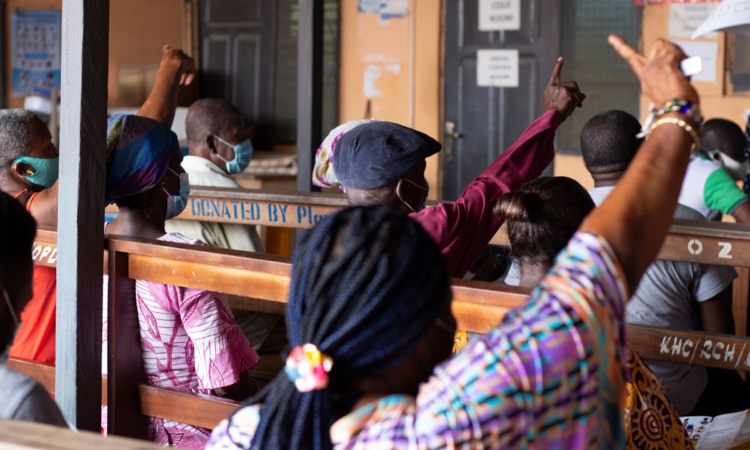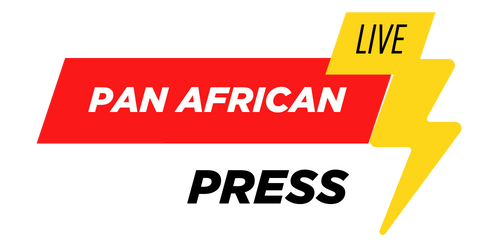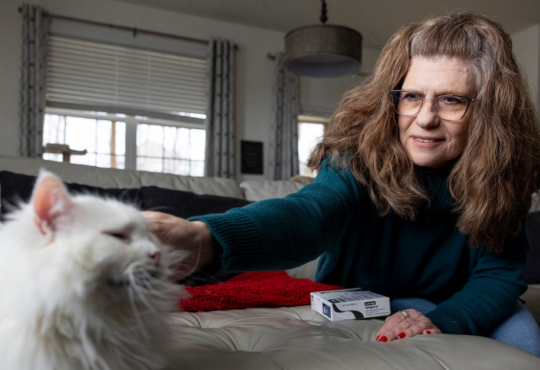Improving Sustainable Health Financing and Primary Health Care to Achieve Universal Health Coverage in Ghana – World Health Organization (WHO)

To achieve its goal of increasing access to essential health services and universal health coverage (UHC) in the context of tight financial constraints, the Government of Ghana has identified the financial sustainability of the health system and strengthening of the primary health care (PHC) system as national priorities that would benefit from collective action. It has therefore selected these two accelerators as the focus areas for work with the “Global Action Plan for Healthy Lives and Well-being for All” (SDG3 GAP) partners.
Collaborations between the SDG3 GAP Sustainable Financing for Health Accelerator (SFHA) partners and the Government have yielded outputs such as the costed Health Sector Medium Term Development Plan (HSMTDP) which was developed with technical, financial and other relevant support from the World Bank, WHO, GFF, UNICEF and other partners. The HSMTDP was based on Ghana’s UHC Roadmap and will serve as a joint plan around which health partners and stakeholders coordinate their work. It will also serve as the basis for determining priorities for the health sector and health investments over the next four years. Another output is the new PHC Investment Programme which aims to improve the quality, utilisation and equity of PHC services and is being implemented by the Government with funding and support from Gavi, GFF and the World Bank.
SDG3 GAP partners have also been providing joint support to the Government of Ghana through the primary health care accelerator (PHC-A ) working group and the national health sector working group (HSWG). The HSWG which is led by the Ministry of Health, supports country coordination by providing a platform for the various stakeholders (Government and partners) to interact and coordinate their activities as well as to identify strategies that can be used to improve the health sector in general.
First Covid-19 vaccination roll-out in National Cardiothoracic Centre of Accra, Ghana. © Gavi/Jeffrey Atsuson
In 2018, the President of Ghana, German Chancellor and Norwegian Prime Minister jointly requested WHO to work collaboratively with other global health-related institutions to develop the SDG3 GAP and support countries in accelerating progress toward the health-related SDGs. As a co-initiator of SDG3 GAP, Ghana has been particularly keen to accelerate progress towards the health-related SDGs in the seven “accelerator” areas. In April 2019, as part of the National Health Summit, the government convened an SDG3 GAP country dialogue with health sector partners to identify areas that would benefit from collective action, as well as opportunities to strengthen PHC and the financial sustainability of the health system.
In 2013, the Government of Ghana established the National Health Insurance Scheme (NHIS), with the goal of increasing access to basic health care services. While the scheme has expanded access to healthcare, it has also faced a number of challenges. Firstly, only 54.4% of the total population is covered by the scheme, with the informal sector making up less than 40% of the membership. In addition, there is a gap in financing cost-effective preventive health services since the NHIS purchases mostly curative services and the Ministry of Health funding for preventive health services is inadequate. Discussions on including preventive services are currently underway. Secondly, there are delays in reimbursement to service providers, which impacts their ability to deliver service to the insured and results in co-payments by service users. Finance therefore remains a significant barrier to accessing healthcare: in 2019, an estimated 36% of health-care expenditure was comprised of out-of-pocket expenses. Consequently, many people must make the difficult choice between either risking health-related economic hardship or not accessing care.
In 2020, the Government of Ghana committed to achieving the goal of at least 80% coverage of essential health services and embarked on a highly ambitious health sector reform programme. A major part of this was the development of the Ghana Universal Health Coverage (UHC) roadmap which set out a strategy and plan for achieving the goal. The roadmap includes six interventions which are focused on consolidating and optimising basic essential services; managing clinical and public health emergencies; improving quality of care and information management; enhancing efficiency in human resource performance; undertaking institutional reforms for sector effectiveness; and strengthening health financing, health policy, and the health system.
As one of the first steps in the implementation of the UHC roadmap, the Ministry of Health developed an Essential Health Services Package (EHSP) with the support of USAID, WHO, UNICEF and the World Bank. The national EHSP consists of an integrated set of cost-effective interventions and services which the Government of Ghana is committed to making progressively accessible to the entire population of the country by 2030.
While implementing the roadmap requires significant financial investment, financing is a major challenge in Ghana, with health spending in 2019 comprising less than 3.5% of GDP. In addition, donor funding has been declining since 2010 when Ghana moved from low-income to lower middle-income status. Between 2015 and 2020, development partner funding for the health sector decreased by an annual rate of over 10%, and the proportion of the health budget represented by donor funding more than halved between 2016 and 2020, going from 13.2% to just 6.3%. To address this reduction in aid and improve the country’s financial stability more broadly, the Government of Ghana has undertaken several initiatives, including the 2019 Ghana Beyond Aid Charter and Strategy which aims to improve resource mobilization and management. However, like many other countries, Ghana’s financial situation has been further weakened by the COVID-19 pandemic which has curtailed economic growth and will likely have negative implications for the availability of resources for the health sector.
Given this context of tight fiscal constraints, the government has been working closely with SDG3 GAP agencies including Gavi, GFF, the Global Fund, the World Bank Group, UNICEF and WHO to finance and implement the UHC roadmap, through the Sustainable Financing for Health Accelerator (SFHA). The process began in early 2020, when GFF proposed supporting operationalization of the UHC Roadmap through the development of an investment case for improving maternal, child and adolescent health. The Government of Ghana, supported by UNICEF, however, requested the development of a costed Health Sector Medium Term Development Plan (HSMTDP) (2022-2025) for the entire health sector.
As part of the process of developing the plan, a number of technical working groups were established to focus on different thematic areas including sustainable financing, clinical and public health emergencies and health service reorganisation. The government and the SDG3 GAP partners then carried out a collaborative review of the previous health sector medium term development plan, to determine whether the objectives had been met and identify strategic shifts required. The review which happened concurrently with the finalisation of the Ghana UHC Roadmap, referred to and was based on the roadmap. Based on the results of the review and the outputs of the various technical working groups, the health priorities for the next four years were determined, and the HSMTDP was prepared. GFF, UNICEF, the World Bank, WHO and other partners provided technical, financial and other support throughout the development of the plan including its costing.
Collaborations on sustainable financing among SDG3 GAP agencies are occurring in addition to the work on HSMTDP. Development partners have established a health financing working group, which meets monthly to discuss financing issues and donor support. A resource mapping exercise co-led by the Government, GFF and the World Bank is also underway. The mapping exercise provides a baseline for understanding the financing currently available for health priorities, the priorities that are funded, and where the money is invested. The exercise aims to identify funding patterns across key priorities and strengthen donor and government alignment around them. To date, the resource mapping for FY21 has been completed and a draft report for FY22-24 has been prepared to inform the fiscal gap analysis for the HSMTDP. There is also an ongoing public expenditure review by the World Bank in collaboration with WHO to identify key health financing challenges of the country, as well as a fiscal space analysis for supporting health financing in Ghana. The Government is also working with Gavi, GFF and the World Bank to fund and implement the PHC Improvement Programme which is focused on improving the quality, utilisation and equity of PHC services, and a Health Financing Strategy is being developed as part of the operationalization of the UHC Roadmap with the support of WHO.
All these collaborations and partnerships are yielding real results for people in Ghana by improving the Government’s ability to broaden the coverage of essential health services. In November 2021, the Government announced that that family planning and the four most common childhood cancers would be included in the National Health Insurance Scheme (NHIS). In addition to advancing progress towards UHC, this policy will also contribute to reducing the risk of adverse maternal and reproductive health outcomes and will improve the prognosis for children who develop childhood cancer.
Alongside the work on sustainable financing, the SDG3 GAP partners have been providing joint support to the government of Ghana on PHC-related activities being implemented through the health sector working group (HSWG). One key output of this is the Network of Practice with a model health centre programme which is being adopted as the model for improving PHC in Ghana. The Network of Practice is a key design feature of Ghana’s UHC Roadmap, and its goal is to reposition Primary Health Care as smart care for everyone regardless of socio-economic status. The programme aims to improve the coverage and quality of preventive, promotive, curative, rehabilitative, palliative, emergency care and mental healthcare by ensuring that health services delivered at the community and sub-district level are supported by and organised within the context of well-defined formal district health system. The programme was developed by the Government, building on experiences from the Primary Healthcare Provider Network pilot implemented by USAID, and is now being rolled-out and scaled-up across the country. Thinking around how to further strengthen the programme is ongoing, notably with regards to identifying the most effective payment mechanism for the programme and ways of improving its financial arrangements, as well as strengthening the Public Financial Management Systems including the fiduciary capacity of personnel at the sub-district level.
The HSWG also strengthens linkages between SDG3 GAP partners and implementing agencies. This improves collaboration between the members of the group and allows their individual expertise and comparative advantage to be leveraged for identifying challenges, solutions and strategies which can be used to support implementing agencies working to improve both PHC service delivery and financing. In addition to this, the working group serves as a platform for the various stakeholders to interact and coordinate their multiple activities – the Ministry of Health has used the platform to discuss and seek input into its work on developing this year’s priority agenda, which was focused on health information systems.
The Global Action Plan for Healthy Lives and Wellbeing for All (SDG3 GAP) is a set of commitments by 13 agencies that play significant roles in health, development and humanitarian responses to help countries accelerate progress on the health-related SDG targets. The added value of the SDG3 GAP lies in strengthening collaboration across the agencies to take joint action and provide more coordinated support aligned to country owned and led national plans and strategies. A “recovery strategy” (Oct 2021) serves as a strategic update on the SDG3 GAP in the context of achieving an equitable and resilient recovery from the COVID-19 pandemic to the health-related SDG targets.
The purpose of GAP case studies is to monitor SDG3 GAP implementation at country level.
Related
SDG3 Global Action Plan
2022 progress report on the Global Action Plan for Healthy Lives and Well-being for All
Country case studies
Feature stories







